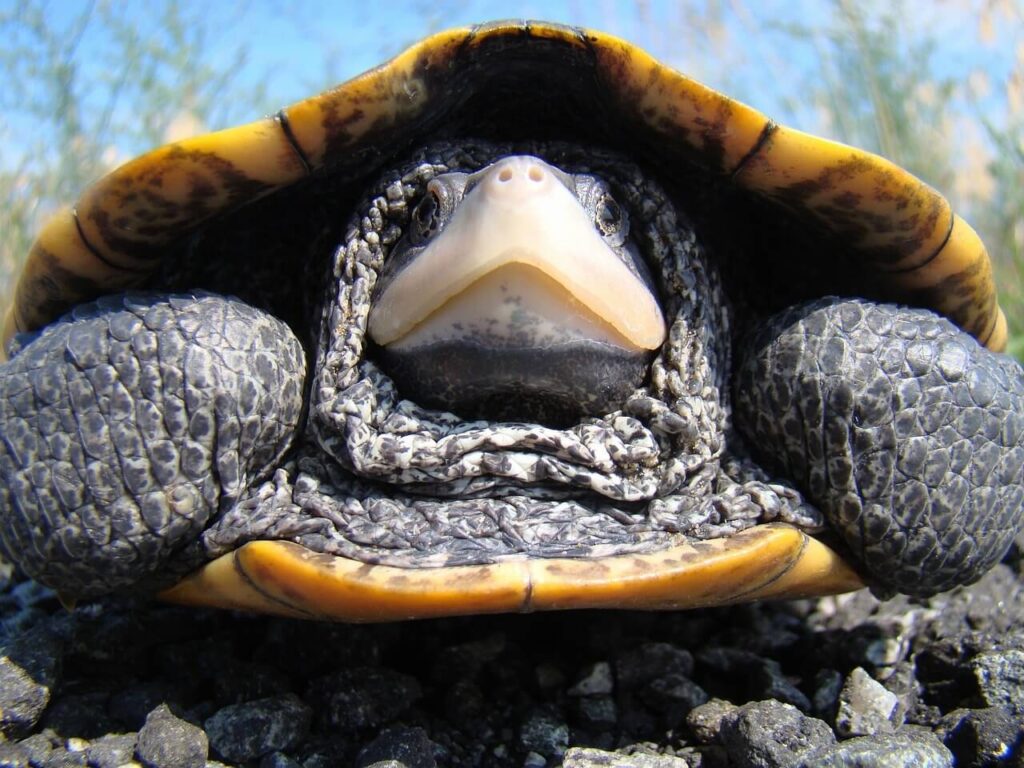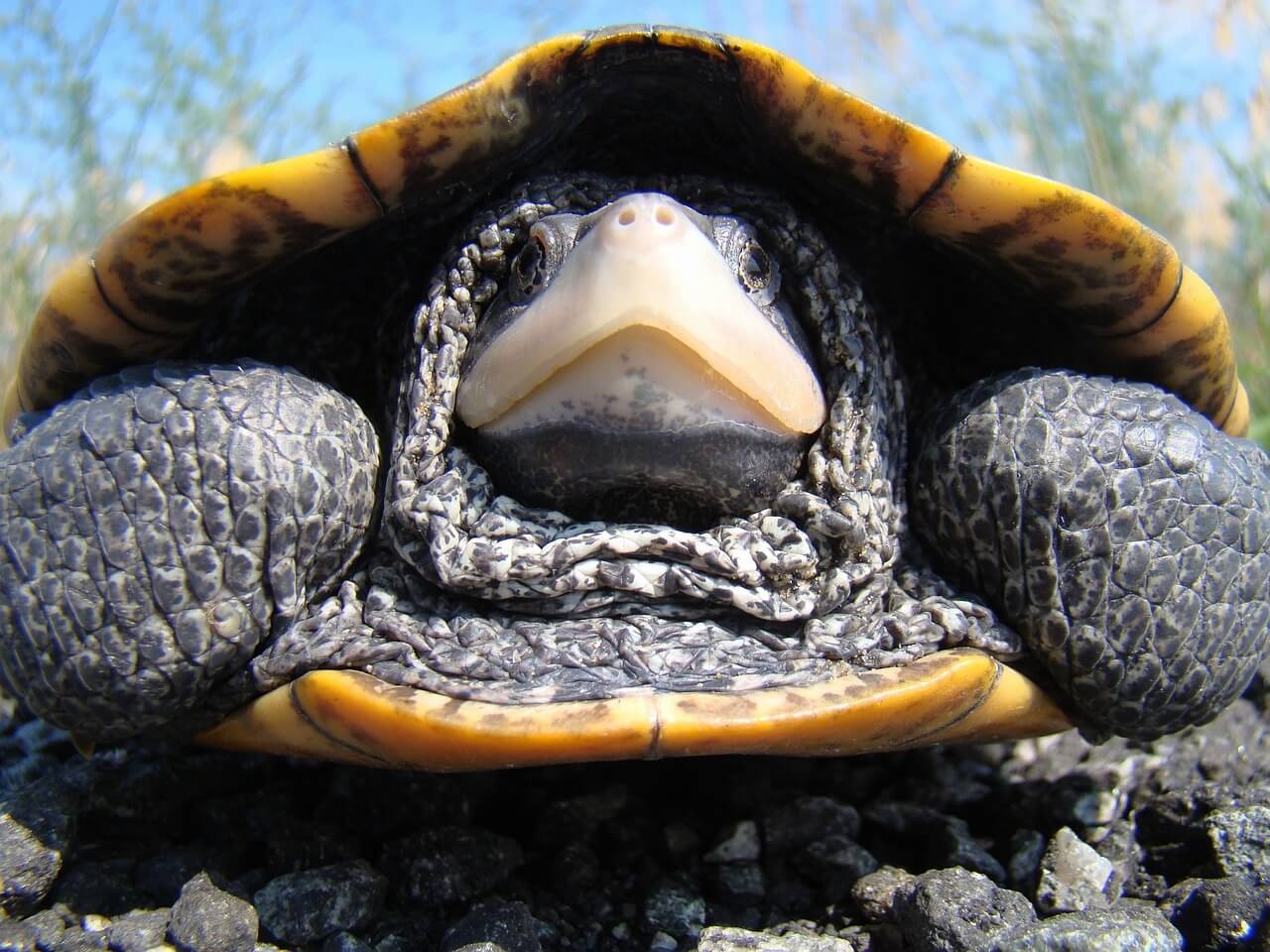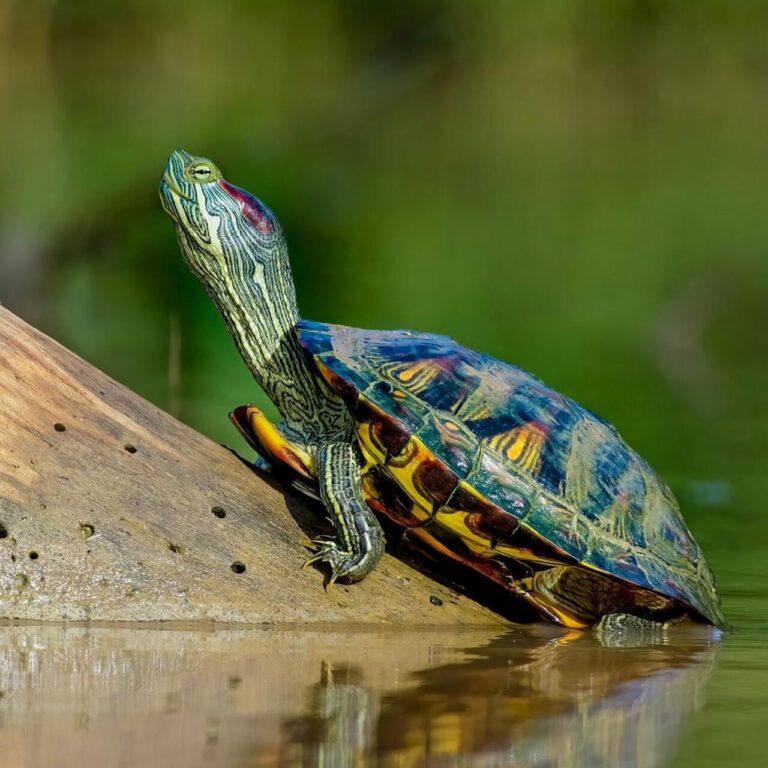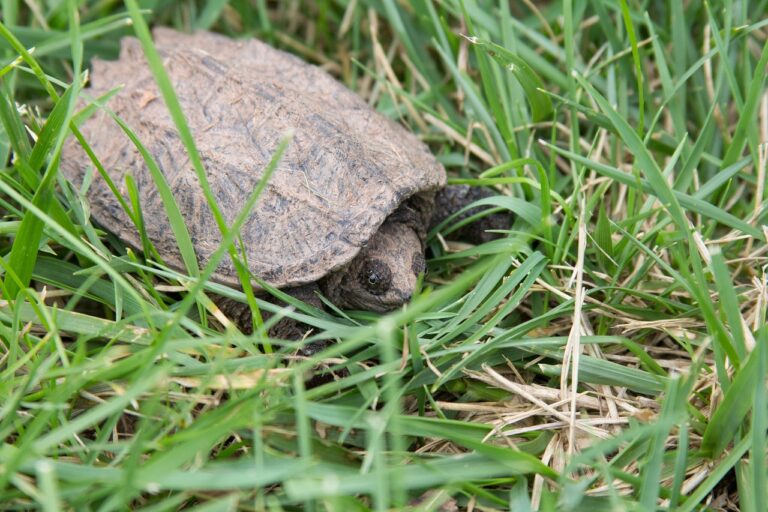The diamondback terrapin, scientifically known as Malaclemys terrapin, is a turtle species that is native to the brackish coastal tidal marshes found along the East Coast of the United States, the Gulf of Mexico coast, and even Bermuda. This unique turtle belongs to the genus Malaclemys and stands as the sole representative of this genus. Notably, it boasts one of the most extensive ranges among all turtle species in North America, with its habitat stretching from the southernmost point in the Florida Keys to as far north as Cape Cod.
The name “terrapin” finds its origins in the Algonquian word “torope.” It is a term used to describe Malaclemys terrapin in both British and American English. Early European settlers in North America initially employed this term to identify these brackish-water turtles that inhabited environments distinct from freshwater habitats and the open sea. In American English, this original meaning still holds. However, in British English, the term “terrapin” might also encompass other semi-aquatic turtle species like the red-eared slider.
Description
The name “diamondback terrapin” is inspired by the distinctive diamond pattern that adorns the top of its shell, known as the carapace. Nonetheless, the specific pattern and coloration of these terrapins exhibit significant variation, making each one unique. No two diamondback terrapins share identical markings or colors. When viewed from above, their shells tend to appear wedge-shaped, wider towards the rear. Shell colors can range from brown to gray, while their body coloration may be gray, brown, yellow, or white. All individuals possess a characteristic pattern of wavy, black markings or spots on both their bodies and heads. Additionally, the diamondback terrapin features large webbed feet.
One remarkable feature of this species is sexual dimorphism. Males typically attain a carapace length of around 13 cm (5 inches), while females grow to an average carapace length of approximately 19 cm (7.5 inches), although some can grow even larger. The largest recorded female had a carapace length slightly exceeding 23 cm (9 inches). Notably, specimens from consistently warmer regions tend to be larger than those hailing from cooler, northern areas. In terms of weight, male diamondback terrapins average around 300 grams (11 ounces), whereas females weigh approximately 500 grams (18 ounces). The largest females can even tip the scales at up to 1 kilogram (35 ounces).

Taxonomy and Classification
Kingdom: Animalia
The diamondback terrapin (Malaclemys terrapin) belongs to the Animalia kingdom, which encompasses all multicellular animals.
Phylum: Chordata
Within the kingdom Animalia, terrapins fall under the phylum Chordata, a group characterized by having a dorsal nerve cord and a notochord at some stage in their life.
Class: Reptilia
Terrapins are classified under the class Reptilia, which includes reptiles like snakes, lizards, and crocodiles.
Order: Testudines
The order Testudines comprises all turtles, including the diamondback terrapin.
Family: Emydidae
Terrapins are further classified into the family Emydidae, which includes freshwater turtles.
Genus: Malaclemys
Within the family Emydidae, the diamondback terrapin belongs to the genus Malaclemys.
Species: terrapin
Finally, the species name is terrapin.
Closely Related Species: The diamondback terrapin has several subspecies, each adapted to specific coastal regions in the United States, including the Northern diamondback terrapin (Malaclemys terrapin terrapin), the Carolina diamondback terrapin (Malaclemys terrapin centrata), and the Texas diamondback terrapin (Malaclemys terrapin littoralis).
Description
Physical Characteristics
Diamondback terrapins are medium-sized turtles with distinctive features. They typically measure 5 to 9 inches (12.7 to 22.9 cm) in carapace length. Their shells exhibit a unique pattern resembling diamond shapes, with various colors such as gray, brown, or black. Males are usually smaller than females.
Sexual Dimorphism
Sexual dimorphism is evident in diamondback terrapins. Females are generally larger than males, and their shells are often wider and more rounded. Additionally, males have longer tails and larger, thicker forelimbs.
Habitat and Range
Natural Habitat
These terrapins are primarily found in the brackish waters of estuaries and coastal marshes along the Atlantic and Gulf coasts of the United States. They are uniquely adapted to this environment, with specialized salt glands to excrete excess salt and a preference for shallow waters.
Geographic Distribution
Diamondback terrapins can be found along the eastern and southeastern coasts of the United States, ranging from Cape Cod, Massachusetts, to the Florida Keys and westward along the Gulf of Mexico to Texas.
Behavior and Diet
Behavior
Diamondback terrapins are semi-aquatic and are known to be both solitary and social. They often bask in the sun on mudflats or logs and are excellent swimmers. Terrapins are known for their distinctive vocalizations, including hisses and grunts.
Diet
Their diet primarily consists of small invertebrates, crustaceans, mollusks, and marine vegetation. They are opportunistic feeders and will adapt their diet based on the availability of food in their habitat.
Reproduction and Life Cycle
Reproductive Behaviors
Mating rituals of diamondback terrapins involve courtship displays by males, who fan their claws and bob their heads to attract females. Nesting typically occurs in sandy areas near the water’s edge.
Nesting Habits
Females lay clutches of eggs in nests they dig in sandy substrates. Each clutch usually contains 4 to 18 eggs, and incubation lasts about two to three months.
Hatchling Survival
Hatchlings face numerous challenges, including predation by birds, crabs, and raccoons. Survival rates vary but are generally low, contributing to the species’ conservation concerns.
Conservation Status
Diamondback terrapins face conservation challenges due to habitat loss, road mortality, and bycatch in crab traps. The IUCN Red List currently lists the species as “Least Concern,” but local populations may be at risk.
Significance and Importance
Ecological Role
Diamondback terrapins play a vital ecological role by controlling populations of invertebrates in their habitats and serving as prey for various predators.
Cultural and Economic Significance
They hold cultural significance in some Native American cultures and have been harvested historically for their meat. Conservation efforts are critical to ensure their survival.
Interesting Facts
- Diamondback terrapins have specialized salt glands that allow them to excrete excess salt, making them well-suited to brackish waters.
- Their diamond-shaped shell patterns are unique to each individual, much like human fingerprints.
- Terrapins are excellent swimmers and can navigate in both freshwater and saltwater environments.
Protection and Conservation Efforts
Efforts to protect diamondback terrapins include habitat preservation, road crossings, and initiatives to reduce bycatch in crab traps. Individuals and organizations can contribute by supporting local conservation programs, reporting injured turtles, and participating in beach clean-ups.
Conclusion
The diamondback terrapin, with its unique appearance and ecological importance, is a species deserving of our attention and conservation efforts. As coastal habitats face increasing threats, understanding and protecting these turtles is crucial to ensuring their continued survival and the health of coastal ecosystems.



